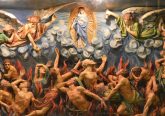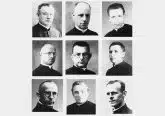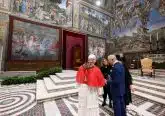Which popes have taken the name Leo?
![]()
Our new Holy Father, Pope Leo XIV, is the latest in a long line of popes who have chosen that name. The thirteen previous popes named Leo date from the fifth century to the beginning of the twentieth century. The last pope with that name died in 1903.
Leo is derived from the Latin for “lion,” symbolizing strength or courage. Not all the Leos were particularly notable, but three deserve mention as particularly impactful on the Church and the papacy’s development.
Leo the Defender
The first Pope Leo—known as Leo the Great—was elected in the mid-fifth century. A strong leader, he persuaded the emperors to recognize his spiritual supremacy. He is best known for convincing Attila the Hun to spare Rome. The unarmed Leo convinced the ruthless warlord to turn away from the city (though he was less successful in repelling the Vandals, who attacked the city three years later).
Leo the Great was also known for clearing up a significant theological disagreement at the Council of Chalcedon. He taught that Jesus had two natures: human and divine, without confusion or separation, “complete in what belonged to him, complete in what belonged to us.” The council members, assenting to the formulation, exclaimed: “Peter has spoken through Leo.” This intervention has been called the most important document ever promulgated by a pope.
Leo the Reformer
Leo IX was pope at the turn of the eleventh century. Recognized as a reformer, he sought to limit outside influence in the selection of bishops, curtail the buying and selling of church offices, and improve the spiritual discipline and moral lives of the clergy.
He was especially well-traveled for the time, convening meetings in France, Germany, and northern Italy— an unusual approach for the bishop of Rome, who, previously, rarely left the city. He transformed the Roman curia from a group of mediocre local clergy into a body of international experts who served as his advisors and promoted reform initiatives.
Leo the Teacher
Pope Leo XIII, one of the longest-reigning popes in history (just short of John Paul II’s 26-year papacy), was considered a master of teaching and communication. He made ample use of encyclical letters (an unmatched 86 are attributed to him), writing on topics ranging from philosophy and Biblical studies to politics. His plan for revitalizing the Christian world, as outlined in his ten major encyclicals, is known as his “grand design.”
He endeavored to provide a framework for a renewed Christian social order based on the thought of St. Thomas Aquinas. He stressed a more conciliatory approach toward secular governments and saw positive aspects of modern culture, which provided new ways for the Church to influence society.
Leo XIII is best known for his teaching on the economy, property, and work (as taught in an encyclical from 1891 titled “Rerum Novarum”). This teaching earned him the distinction of being the father of modern Catholic social teaching and a chief contributor to the Church’s teachings on human dignity and freedom.
A New Leo
When Cardinal Robert Prevost chose the name, he became the fourteenth Leo. The name is now tied with Clement as the fourth most common papal name, behind John, Gregory, and Benedict. Of the previous popes named Leo, five have been canonized as saints (including Leo the Great and Leo IX).
Leo XIV’s choice of this name has been rightly linked to Leo XIII’s concern for human dignity and the Church’s social teaching, but the new Holy Father has also connected himself to many strong and courageous Popes Leo—just as the name implies.
 Father David Endres, [email protected], is professor of Church history and historical theology at Mount St. Mary’s Seminary & School of Theology.
Father David Endres, [email protected], is professor of Church history and historical theology at Mount St. Mary’s Seminary & School of Theology.
This article appeared in the July 2025 edition of The Catholic Telegraph Magazine. For your complimentary subscription, click here.













